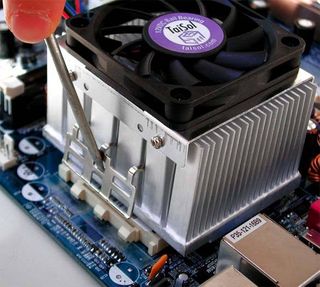A New Kind Of Fast: AMD Athlon XP 2200+
Overclocking: Not A Whole Lot Possible
Prior to the test, the THG engineers had some rather high expectations: overclocking with the smaller CPU core should prove to be easily accomplished. The serial settings run at 13.5 x 133 MHz = 1800 MHz. But our attempt to overclock the processor's FSB to 148 MHz, similar to the Athlon XP 2100+ (Palomino), failed. Here, it should be mentioned that both systems were operated with a high-quality watercooling setup. The result: the system remained stable only at 140 MHz FSB, meaning that the CPU clock was increased to 1890 MHz. This is an increase of 5%, which is clearly a weaker result than with the older Palomino, which ran with perfect stability at 1918 MHz (11.2% increase).
Not A Topic: 166 MHz FSB
Despite the many rumors of an increased FSB clock frequency, AMD will not be increasing the clock from 133 MHz to 166 MHz for either the Thoroughbred or its successor, the Barton. Also, there are officially no chipsets that have standard support for 166 MHz FSB.
New Guidelines For CPU Coolers: No Cheap Models

A new AMD-approved CPU cooler for the Athlon XP 2200+ with high contact pressure.
When switching from the Athlon XP with the Palomino core to the Athlon XP with the Thoroughbred core, the topic of sufficiently cooling the processor becomes increasingly important. Even though the new Athlon XP has only a marginal performance increase (5.7% less with the top 2200+ model than the previous model with the Palomino), a higher quality CPU cooler is necessary.
To explain this - since the CPU surface has been reduced by 40%, this means that there's automatically less surface area to dissipate the heat. Here, we wonder why AMD doesn't use a heat spreader à la Intel Pentium 4 or AMD "Hammer". For OEM manufacturers and buyers of the new Athlon XP processors, there are new guidelines from AMD, valid starting June 10, 2002:
Stay on the Cutting Edge
Join the experts who read Tom's Hardware for the inside track on enthusiast PC tech news — and have for over 25 years. We'll send breaking news and in-depth reviews of CPUs, GPUs, AI, maker hardware and more straight to your inbox.
Current page: Overclocking: Not A Whole Lot Possible
Prev Page Clock Increase And Heat Dissipation Next Page New Guidelines For CPU Coolers: No Cheap Models, ContinuedMost Popular

